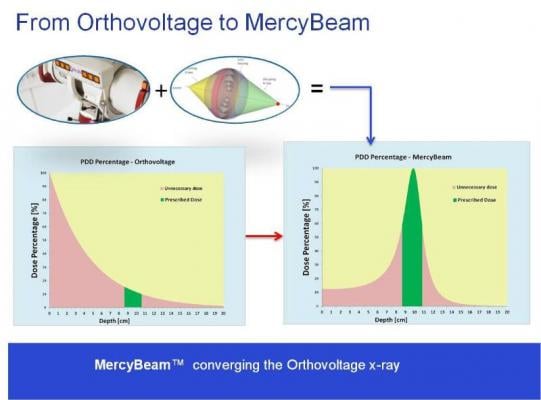
CRnR - image 1. (PRNewsFoto/Convergent R.N.R Ltd.)
April 1, 2014 — Convergent R.N.R Ltd. (CRnR) completed a very successful and promising proof of concept session of the Mercy Beam technology, that will enable more accurate, less harmful and dramatically less expensive radiotherapy and radiosurgery treatment using low-energy X-ray tube instead of high-energy sources commonly used today.
The Mercy Beam introduces a sophisticated lens that collects most of the X-rays emanating divergently out of any standard X-ray tube (currently used for X-ray imaging) and converges it towards the tumor location. The lens simultaneously removes low-energy photons that would be absorbed by the patient's skin. The convergence increases the therapeutic dose delivered at the tumor location, while the organs in the vicinity of the tumor receive a very low dose or no dose at all. The converging technology enables the use of photon-energy X-rays 100 times lower than those used by current systems, which are based on linear accelerators (LINACs). Due to its low energy requirement, this technology enables a small, light and inexpensive solution in which the cancer is treated accurately with a concentrated radiation at a fraction of the cost of all other methods.
"Today's radiation treatment and surgery uses very high energy X-ray radiation that not only penetrates the body to reach the tumor, but also scatters towards the surrounding environment including healthy tissue, causing unwanted damage," said Zeev Harel, CEO of CRnR. He added: "To deal with such high energy X-rays, the protocol requires the machine installation inside a room of several feet of concrete walls, and heavy lead doors, which make those solutions even more expensive. Mercy Beam would revolutionize cancer treatment as we know it today, allowing many patients to receive a merciful, efficient and affordable treatment. The use of low energy X-rays will enable operating the system in standard X-ray rooms (no need for 'special bunkers') and in the future even in vans/lorries/trailers that may travel to remote areas. The technology is targeted for treating many types of cancerous tumors with an emphasis on treating of small children."
For more information: www.mercybeam.com


 August 09, 2024
August 09, 2024 








